- Home
- Forums
- Military Vehicles
- Military Vehicles Under Construction
- Armoured Vehicles Under Constuction
You are using an out of date browser. It may not display this or other websites correctly.
You should upgrade or use an alternative browser.
You should upgrade or use an alternative browser.
Bronco 1/35 Schwerer Wehrmachtschlepper (SWS) armoured version halftrack
- Thread starter Panzerwrecker
- Start date
Panzerwrecker
SMF Supporter
Cheers Rick
Yep, long overdue
Yep, long overdue

Scratchbuilder
SMF Supporter
Los, appologies for not dropping in to see your build earlier, but what I have seen up to now - brilliant.
That 'Paper Shaper' is a product I wish was around decades ago, it saves so much mess and trouble.
Looking forward to more of your build.
Mike.
That 'Paper Shaper' is a product I wish was around decades ago, it saves so much mess and trouble.
Looking forward to more of your build.
Mike.
Panzerwrecker
SMF Supporter
It's been a while since the sWS got any quality attention but I have been pottering with it on and off this year. The road wheel tyres were airbrushed with Tamiya Tyre Black and individual accessories painted.
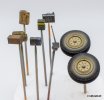
Before the cab assemblies can be fixed together the instrument binnacle, radio and wiring, seats and roof tarp were brush painted with Vallejo acrylics and the instrument decals added. My kit included two sets which was fortunate as decal number one did not represent the large left hand dial in anyway shape or form. Decal number two was used twice to represent the largest dials and some extra placards were also added from my decal spares box.
To seal in the paintwork and prepare for the external decals and all the upcoming weathering stages I turned to my favourite product, VMS satin varnish. This can be airbrushed direct from the bottle with a little thinner giving the model a good wet coat to level. It can be left a couple of hours in-between coats if required.
Exterior decals for this kit include just Wehrmacht number plates which you can add your own individual numbers, a weight stencil, one divisional insignia and a 'Thor' vehicle name seen on one period image. I added just the weight and number plates. These were sealed with another coat of VMS satin varnish.
This is the only internal reference pic I have. The instrument binnacle appears to sit a little higher than it does in the open top cargo variant. I'm not convinced a radio was fitted to these cargo vehicles. As I added the one provided in the kit I will now have to find a suitable spot on the exterior to add the aerial mount.
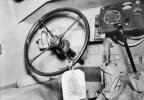
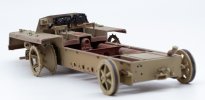
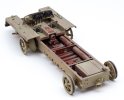
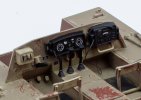
Before the cab received its final weathering and tones down all those severe chipped effects, a light coat of sand coloured lifecolor acrylics was airbrushed over a coat of hairspray over all the sub assemblies and scrubbed back, leaving remnants of the sand colour to simulate the first layers of dust and light dirt build up. A further coat of VMS satin varnish sealed all the work in preparation for the upcoming pin washes.
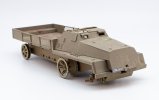
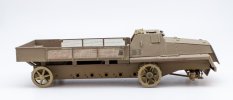
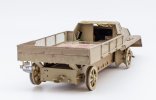
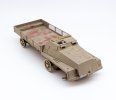
As I would like to represent this vehicle in a late 1944 ETO setting the wet and damp conditions will require a darker coloured pin wash to add to the muddy running gear and lift the contrast to the monochrome base coat. More vibrant colours will be added by way of the accessories in the load area.
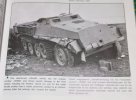
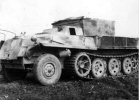
Next up is to complete the cab interior, close it up and get some muddy wet weathering effects on the lower chassis.

Before the cab assemblies can be fixed together the instrument binnacle, radio and wiring, seats and roof tarp were brush painted with Vallejo acrylics and the instrument decals added. My kit included two sets which was fortunate as decal number one did not represent the large left hand dial in anyway shape or form. Decal number two was used twice to represent the largest dials and some extra placards were also added from my decal spares box.
To seal in the paintwork and prepare for the external decals and all the upcoming weathering stages I turned to my favourite product, VMS satin varnish. This can be airbrushed direct from the bottle with a little thinner giving the model a good wet coat to level. It can be left a couple of hours in-between coats if required.
Exterior decals for this kit include just Wehrmacht number plates which you can add your own individual numbers, a weight stencil, one divisional insignia and a 'Thor' vehicle name seen on one period image. I added just the weight and number plates. These were sealed with another coat of VMS satin varnish.
This is the only internal reference pic I have. The instrument binnacle appears to sit a little higher than it does in the open top cargo variant. I'm not convinced a radio was fitted to these cargo vehicles. As I added the one provided in the kit I will now have to find a suitable spot on the exterior to add the aerial mount.




Before the cab received its final weathering and tones down all those severe chipped effects, a light coat of sand coloured lifecolor acrylics was airbrushed over a coat of hairspray over all the sub assemblies and scrubbed back, leaving remnants of the sand colour to simulate the first layers of dust and light dirt build up. A further coat of VMS satin varnish sealed all the work in preparation for the upcoming pin washes.




As I would like to represent this vehicle in a late 1944 ETO setting the wet and damp conditions will require a darker coloured pin wash to add to the muddy running gear and lift the contrast to the monochrome base coat. More vibrant colours will be added by way of the accessories in the load area.


Next up is to complete the cab interior, close it up and get some muddy wet weathering effects on the lower chassis.
Panzerwrecker
SMF Supporter
The cab has been closed up. There are only four tiny locating holes to connect top and bottom cab assemblies and with the lower half having a slight downward bow a few clamps were required to hold it while the glue cured. There is a little clean up required but TBH it could just as well be hidden with dust and debris.
I have taken a few pics looking inside and while these images are always tricky to shoot with so little light available, I think there is just enough to see. While the two halves were separate I used a MIG neutral wash to highlight raised detail with a drop of MIG Dark wash added to darken corners and use to lightly speckly the floor and sidewalls. I still need to use a pencil to add a burnished sheen to a few places
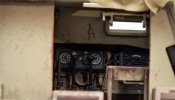
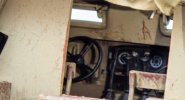
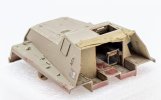
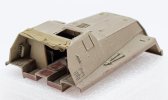
Next up is to get the muddy running gear ref pics out and weather up the chassis and wheels.
I have taken a few pics looking inside and while these images are always tricky to shoot with so little light available, I think there is just enough to see. While the two halves were separate I used a MIG neutral wash to highlight raised detail with a drop of MIG Dark wash added to darken corners and use to lightly speckly the floor and sidewalls. I still need to use a pencil to add a burnished sheen to a few places




Next up is to get the muddy running gear ref pics out and weather up the chassis and wheels.
Very nice updates glad your back at it.
scottie3158
SMF Supporter
Very nice work mate.
Scratchbuilder
SMF Supporter
Nearly missed this great build, lots to look at and read about.
Panzerwrecker
SMF Supporter
I’ll be honest, I’ve never attempted a muddy finish on an AFV so this is going to be interesting. Watching a few videos and taking inspiration from the guys that like to build vehicles set in the eastern European theatre it was clear that to pull this off I would have to step carefully. I plan to make the lower chassis and running gear very muddy but not to cover it up entirely if that makes sense.
My first decision was what materials to use. The AK acrylic textured weathering paste is a product I’ve used and their dark mud in particular is a nice authentic tone so would fit perfectly into my late Autumn 44 setting in Belgium. It is easy to apply and easy to clean up if I take things a little too far! Mixing tea leaves into the paste will also give it additional volume. The first steps are to add some texture and looking at real muddy tank images the wheels at the rear seam to pick up more of the track dirt that is kicked up and propelled over the upper track run. With this in mind I would leave some wheels cleaner than others.
To get my eye in I started with the underside of the load bed. I could experiment with both quantities and the positioning of the products without worrying too much as only a fraction of these areas will be visible. I also added AK acrylic light mud, but I really didn’t need to. I was hoping this could replicate a few areas of dried mud, but I applied it after the dark mud had dried and really should have added both at the same time so they could be blended more.

Once the acrylic texture paste had dried, I used AK dark mud enamels and blended them with white spirit. This product was a fair bit lighter that the acrylic paste, so I went back over selected areas with it thinned with tap water. I also added streaks onto the chassis legs but much of them will be hidden by further effects. Much like with weathering tracks I then used the speckling technique, using AK enamels with a small amount of MIG dark mud pigments to add some texture. This all looks very messy for now, so I let it dry up and started work on the tracks and wheels.

The tracks were first primed with Tamiya Fine Surface primer and then base coated in MRP-034 tank grey. I then randomly washed on and then speckled my pre-mixed acrylic rain wash. Once dry a mix of AK acrylic dark mud texture paste and sea grass was added, smoothing over the cleats trapping the mud in between, so I didn’t get too much build up. I left the inner portions completely clear for now as any texture build up could interfere with the fit of the road wheels.

The main running wheels received far less overall mud texture than the chassis and was just added to selected areas. Learning from my mistake on the underside of the load bed the effects were added in two stages. First a build-up of light mud textured paste then before it completely dried some dark mud. After it was allowed to dry fully AK enamel mud was thinned with white spirit and blended onto the surface.

The steering wheels received a slightly reserved application.

The idlers, with a build-up of textured acrylic mud between the spokes.

The next steps involved adding splatters of mud to the wheels. A mixture of AK dark mud speckling and MIG dark mud pigments were mixed together and applied with a cocktail stick and brush. Keeping the speckling random and just to selected areas was my aim but I found it tricky without masking and often had to tone it down with a brush moistened with white spirit. This is the first round of both speckling and mapping with two slight variations on the dark mud tone and one with a lighter one.


The next round of weathering will need to be more precise. This will involve just oils with the aim of adding more interest, some more variation in earth tones and to highlight raised detail and create grease and oil stains to the hubs.
My first decision was what materials to use. The AK acrylic textured weathering paste is a product I’ve used and their dark mud in particular is a nice authentic tone so would fit perfectly into my late Autumn 44 setting in Belgium. It is easy to apply and easy to clean up if I take things a little too far! Mixing tea leaves into the paste will also give it additional volume. The first steps are to add some texture and looking at real muddy tank images the wheels at the rear seam to pick up more of the track dirt that is kicked up and propelled over the upper track run. With this in mind I would leave some wheels cleaner than others.
To get my eye in I started with the underside of the load bed. I could experiment with both quantities and the positioning of the products without worrying too much as only a fraction of these areas will be visible. I also added AK acrylic light mud, but I really didn’t need to. I was hoping this could replicate a few areas of dried mud, but I applied it after the dark mud had dried and really should have added both at the same time so they could be blended more.

Once the acrylic texture paste had dried, I used AK dark mud enamels and blended them with white spirit. This product was a fair bit lighter that the acrylic paste, so I went back over selected areas with it thinned with tap water. I also added streaks onto the chassis legs but much of them will be hidden by further effects. Much like with weathering tracks I then used the speckling technique, using AK enamels with a small amount of MIG dark mud pigments to add some texture. This all looks very messy for now, so I let it dry up and started work on the tracks and wheels.

The tracks were first primed with Tamiya Fine Surface primer and then base coated in MRP-034 tank grey. I then randomly washed on and then speckled my pre-mixed acrylic rain wash. Once dry a mix of AK acrylic dark mud texture paste and sea grass was added, smoothing over the cleats trapping the mud in between, so I didn’t get too much build up. I left the inner portions completely clear for now as any texture build up could interfere with the fit of the road wheels.

The main running wheels received far less overall mud texture than the chassis and was just added to selected areas. Learning from my mistake on the underside of the load bed the effects were added in two stages. First a build-up of light mud textured paste then before it completely dried some dark mud. After it was allowed to dry fully AK enamel mud was thinned with white spirit and blended onto the surface.

The steering wheels received a slightly reserved application.

The idlers, with a build-up of textured acrylic mud between the spokes.

The next steps involved adding splatters of mud to the wheels. A mixture of AK dark mud speckling and MIG dark mud pigments were mixed together and applied with a cocktail stick and brush. Keeping the speckling random and just to selected areas was my aim but I found it tricky without masking and often had to tone it down with a brush moistened with white spirit. This is the first round of both speckling and mapping with two slight variations on the dark mud tone and one with a lighter one.


The next round of weathering will need to be more precise. This will involve just oils with the aim of adding more interest, some more variation in earth tones and to highlight raised detail and create grease and oil stains to the hubs.
Last edited:
Mud is easy but it can be over done and not convincing great idea.
scottie3158
SMF Supporter
Very nicely done very convincing effect.
Panzerwrecker
SMF Supporter
Great work! Very well and realistically implemented. I'm excited to see what the chassis looks like when assembled.
Mud is easy but it can be over done and not convincing great idea.
Very nicely done very convincing effect.
Thanks guys, I've got quite a few reference images to help me along the way. The main thing to consider is if you are going for an overall wet mud effect or combining both wet and dry mud effects. The vehicle image I am using shows the mud on the running gear is very dark overall with a few patches of dry mud on the steering tyres. The bodywork however has both dark and light mud. Building up the mud texture in stages works much better than just one application but this is defo a learning on the job affair. The AK Texture paste is an excellent product as you can blend and clean it up with just tap water. Thoroughly recommended
Panzerwrecker
SMF Supporter
Beginning where we left off, I first tidied up any rough areas on the chassis legs so the running gear could be fitted. Before any more weathering could begin the wheels and tracks had to be fitted. I had used the kit individual links, and they were a little tricky to build around the wheels and be kept separate for painting. In hindsight I think it would have been easier to fix all the swing arms to the chassis minus just the outer wheels.
Before the tracks were fitted, I added graphite to the inner portions of the tracks where the tyres and wheels made contact and also to the sprocket teeth. As my swing arms and wheels were still not fixed, I had to both line these up straight on the chassis and ensure the tracks lined up as they had pre-paint. This is never guaranteed, and they both put up quite a fight. I ended up using CA glue on the tracks and the fit to one of the sprockets and over one of the idlers wasn’t ideal and I will likely look at improving these. On the plus side having so much mud around the running gear means it was much easier to blend over all the new attachment points. The vehicle is to be placed on some undulated terrain and as the steering wheels were articulated on the central leaf spring it is sat at a slightly jaunty angle. I haven't glued the lower track run to the wheels so any visible gaps showing now will disappear once it sits on its base.



The steering wheels received some enamel washes and pigments should round these off in a future step.

Now the running gear was finally attached I could begin adding further weathering effects. Each wheel was dealt with separately, tidying up any overscale effects and adding both rust, oil and grease effects with enamels. The AK texture mud was also used again but in minute quantities just to blend in areas that required a little improvement. A dark mud pigment thinned with white spirit added a slight tonal variation to the thicker clumps of mud.
As I was conscious of how fragile the track runs now were I used pigments and kept the washes to acrylics only. I will leave it all to dry for 24hrs and then decide if it requires any more work.
With the cab assembly dry fitted




Before the tracks were fitted, I added graphite to the inner portions of the tracks where the tyres and wheels made contact and also to the sprocket teeth. As my swing arms and wheels were still not fixed, I had to both line these up straight on the chassis and ensure the tracks lined up as they had pre-paint. This is never guaranteed, and they both put up quite a fight. I ended up using CA glue on the tracks and the fit to one of the sprockets and over one of the idlers wasn’t ideal and I will likely look at improving these. On the plus side having so much mud around the running gear means it was much easier to blend over all the new attachment points. The vehicle is to be placed on some undulated terrain and as the steering wheels were articulated on the central leaf spring it is sat at a slightly jaunty angle. I haven't glued the lower track run to the wheels so any visible gaps showing now will disappear once it sits on its base.



The steering wheels received some enamel washes and pigments should round these off in a future step.

Now the running gear was finally attached I could begin adding further weathering effects. Each wheel was dealt with separately, tidying up any overscale effects and adding both rust, oil and grease effects with enamels. The AK texture mud was also used again but in minute quantities just to blend in areas that required a little improvement. A dark mud pigment thinned with white spirit added a slight tonal variation to the thicker clumps of mud.
As I was conscious of how fragile the track runs now were I used pigments and kept the washes to acrylics only. I will leave it all to dry for 24hrs and then decide if it requires any more work.
With the cab assembly dry fitted




Last edited:
scottie3158
SMF Supporter
SuperbBeginning where we left off, I first tidied up any rough areas on the chassis legs so the running gear could be fitted. Before any more weathering could begin the wheels and tracks had to be fitted. I had used the kit individual links, and they were a little tricky to build around the wheels and be kept separate for painting. In hindsight I think it would have been easier to fix all the swing arms to the chassis minus just the outer wheels.
Before the tracks were fitted, I added graphite to the inner portions of the tracks where the tyres and wheels made contact and also to the sprocket teeth. As my swing arms and wheels were still not fixed, I had to both line these up straight on the chassis and ensure the tracks lined up as they had pre-paint. This is never guaranteed, and they both put up quite a fight. I ended up using CA glue on the tracks and the fit to one of the sprockets and over one of the idlers wasn’t ideal and I will likely look at improving these. On the plus side having so much mud around the running gear means it was much easier to blend over all the new attachment points. The vehicle is to be placed on some undulated terrain and as the steering wheels were articulated on the central leaf spring it is sat at a slightly jaunty angle. I haven't glued the lower track run to the wheels so any visible gaps showing now will disappear once it sits on its base.
View attachment 511123View attachment 511124View attachment 511125
The steering wheels received some enamel washes and pigments should round these off in a future step.
View attachment 511126
Now the running gear was finally attached I could begin adding further weathering effects. Each wheel was dealt with separately, tidying up any overscale effects and adding both rust, oil and grease effects with enamels. The AK texture mud was also used again but in minute quantities just to blend in areas that required a little improvement. A dark mud pigment with a slightly thinned with white spirit added a slight tonal variation to the thicker clumps of mud.
As I was conscious of how fragile the track now runs were I used pigments and kept the washes to acrylics only. I will leave it all to dry for 24hrs and then decide if it requires any more work.
With the cab assembly dry fitted
View attachment 511127View attachment 511128View attachment 511129
Stefee
SMF Supporter
So realistic.
Panzerwrecker
SMF Supporter
Superb
Thanks guysSo realistic.
You might have noticed in the above pics that the exhaust muffler isn't painted. In my haste to weather the running gear, I completely forgot to add any effects to it before it got covered in mud splatters. I was now left with two options. One: add a small amount of rust effects to the base coloured paint or two: start afresh and re-work the whole muffler. I realise such a short operational life might not have exposed quite so much weathering to it, but to give it a more interesting appearance I went with option two.
This was completed with the brilliant Lifecolor acrylic rust set and a drop of acrylic off white for the initial coat. I started by mixing the off white with the darkest rust colour to try and replicate that pinky hot manifold tone. Next was to add the three darkest rust tones, going from the lightest to the darkest colour, both by adding diluted coats and by speckling, gradually building up the layers until I felt I was getting somewhere. Adding a minute amount of the lightest rust tone completed the painting step. MIG smoke pigment was added in and around the end of the pipe. The last effect was to add a few baked mud splatters back over it.
I'm still not 100% convinced with the overall pinkish hue but thats the colour I see in a lot of my rusty muffler reference images
A quite fortuitous consequence of the splattered mud effects is that it has added a little texture.






The next step is to start weathering the cab and loadbed exterior.
Tworrs
SMF Supporter
Well Los you could have fooled me, it looks like the real deal to me.
scottie3158
SMF Supporter
Superb attention to detail.

